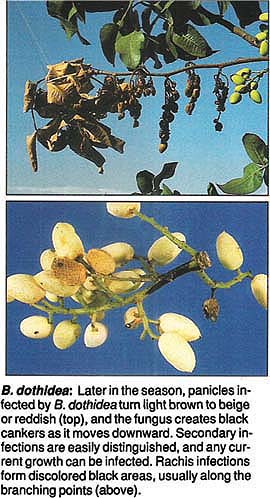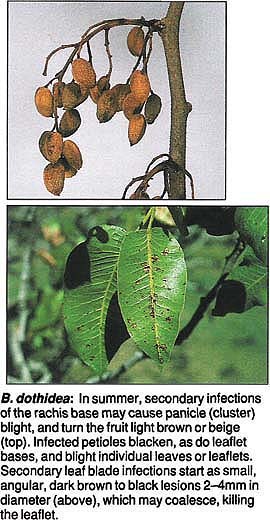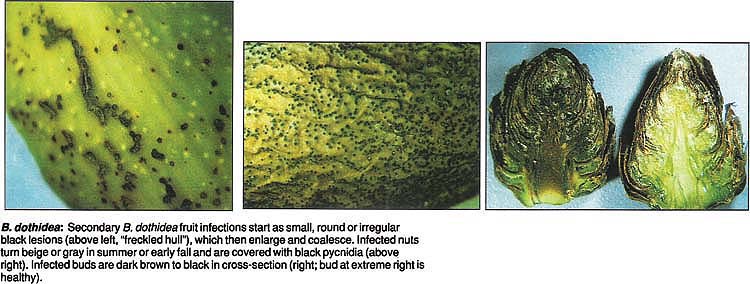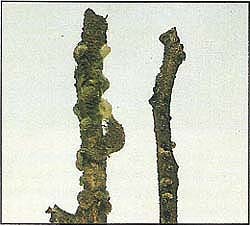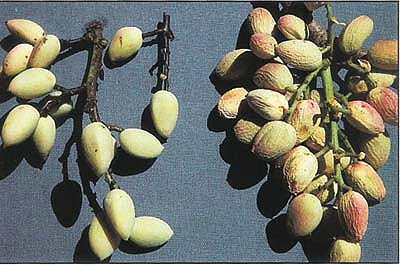All Issues
Three common pests of pistachio in California
Publication Information
California Agriculture 44(3):6-8.
Published May 01, 1990
PDF | Citation | Permissions
Abstract
Similar symptoms do not always indicate the same problem. Only close examination reveals the difference between early Botrytis and Botryosphaeria blights on pistachio. Later on, Botryosphaeria blight can be confused with an infestation of citrus flat mite.
Full text
Botrytis cinerea produces spores (conidia) on branched conidiophores (above) and on black sclerotia, which resist environmental stress. White, one-celled Botryosphaeria dothidea spores (below) are produced in flasklike pycnidia. Flasklike perithecia of B. dothidea and the ascospores they produce occur in California only on two conifer species: the coast redwood (Sequoia sempervirens) and giant sequoia (Sequoiadendron giganteum).
In 1983, after heavy, prolonged rains and cool weather, California growers reported a new disease blighting pistachio shoots and flowers. Investigators identified its cause as the asexual stage of grey mold fungus, Botrytis cinerea Pers. Botrytis belongs to the fungal family that causes brown rot of stone fruits (Monilinia fructicola) and that includes the Sclerotinia species.
In 1984, growers observed another disease in two Butte County orchards. Affected trees showed small black spots on the fruit surface and blighting on the branched stems supporting the fruit (California Agriculture, January-February 1985). Isolations from the dead spots, blighted clusters (panicles), and branched stems (rachises) bore the fungus Botryosphaeria dothidea (Moug.: Fr.) Ces. & de Not. On pistachio trees, the asexual stage of this fungus causes panicle and shoot blight.
These two aerial blight diseases of pistachio have similar symptoms in mid to late spring. Later (from July to September), Botryosphaeria symptoms on rachises and fruits are easily confused with those caused by the citrus flat mite, Brevipalpus lewisi McGregor (Acarina: Tenuipalpidae).
Botrytis cinerea and Botryosphaeria dothidea: early symptoms
Botrytis cinerea: In early to mid spring (April-May), Botrytis cinerea blights young shoots, turning them brown at the base and causing their leaves to wilt and dry (left). Young blossoms may also be infected. Fungal growth (sporulation), usually a buff-colored mass at the shoot base, can also be present at the center of male blossoms (above left) or the inner side of flower scales. Conidiophores with conidia (on shoot base, above right) can occur from February to early March on shoots blighted during the current or previous spring. If no such sporulation is apparent on the shoot, a fungal sample must be taken to identify the pathogen.
Botryosphaeria dothidea: Among the first visible signs of Botryosphaeria dothidea infection is the mid-spring wilting of young shoots (left) developed from buds infected the previous fall. During spring, infected young fruit clusters turn black, wilt, and die (above left), as do infected shoots and leaves. The fungus may later sporulate on the base of the infected shoot. A cross-section of the shoot's bark reveals the pycnidia (above right, white dots).
Botrytis cinerea and Botryosphaeria dothidea: late symptoms
B. cinerea: In late spring and in summer, enlarged Botrytis cankers girdle and blight shoots (above). The cankers originate in Botrytis-infected male blossoms and can eventually be colonized by B. dothidea.
B. dothidea: Secondary B. dothidea fruit infections start as small, round or irregular black lesions (above left, “freckled hull”), which then enlarge and coalesce. Infected nuts turn beige or gray in summer or early fall and are covered with black pycnidia (above right). Infected buds are dark brown to black in cross-section (right; bud at extreme right is healthy).
B. dothidea: Later in the season, panicles infected by B. dothidea turn light brown to beige or reddish (top), and the fungus creates black cankers as it moves downward. Secondary infections are easily distinguished, and any current growth can be infected. Rachis infections form discolored black areas, usually along the branching points (above).
B. dothidea: Infections from B. dothidea (this one initiated from an infected bud) can cause cankers, discoloring the bark and cambium above and below the infection point (left). Cankers near male flowers can be mistaken for B. cinerea symptoms. Bud infections can begin in August, but most occur in fall, as late as October. Large, dead lesions indicate leaf infections (above).
B. dothidea: In summer, secondary infections of the rachis base may cause panicle (cluster) blight, and turn the fruit light brown or beige (top). Infected petioles blacken, as do leaflet bases, and blight individual leaves or leaflets. Secondary leaf blade infections start as small, angular, dark brown to black lesions 2-4mm in diameter (above), which may coalesce, killing the leaflet.
B. dothidea: Spores of B. dothidea are embedded in a mucilaginous matrix that swells when wet, forcing them out of the pycnidia as gel strings (cirrhi, shown above). High relative humidity can also cause pycnidia to exude spores, and rain or sprinkler irrigation will spread the spores to new infection sites.
B. cinerea: In late winter, B. cinerea emerges from dormancy to produce sclerotia on infected shoots, mainly on those pruned and left on the ground.
Citrus flat mite and Botryosphaeria dothidea
Citrus flat mite: Rachises infested with citrus flat mite are black and very brittle. A light infestation (above left; the rachis on the right is healthy) results in superficial patchy, scab-like black lesions intermixed with healthy, bright greenish or reddish areas.
Mite: During summer or at harvest time, mite-infested clusters (rachises and fruit) are withered and dried (above left; dead rachis at right was infected with B. dothidea). Most fruit on mite-infested rachises mature and become blighted after kernel development.
Mite: A heavy infestation of citrus flat mite turns the entire rachis surface black, although in cross-section the inside tissues look green and healthy (above: left, mite infestation; center, B. dothidea infection; right, healthy rachis). Rachis infections of B. dothidea eventually extend to interior tissues, turning them brown or black.
Mite: When citrus flat mites feed on the pistachio hull, they create patchy, irregular, superficial dark brown to black lesions that may be slightly raised or blistered (corky). Inset: A hand lens will easily show the mites feeding in these areas, (photo courtesy of R. E. Rice)







